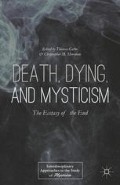Abstract
Warning: according to Terror Management Theory (TMT), the following essay could be disturbing. Sigmund Freud, however, believed we could not afford to neglect this disturbing subject matter:
Is it not for us to confess that in our civilized attitude towards death we are once more living psychologically beyond our means, and must reform and give truth its due? Would it not be better to give death the place in actuality and in our thoughts which properly belongs to it, and to yield a little more prominence to that unconscious attitude towards death which we have hitherto so carefully suppressed? This hardly seems a greater achievement, but rather a backward step … but it has the merit of taking somewhat more into account the true state of affairs.1
Access this chapter
Tax calculation will be finalised at checkout
Purchases are for personal use only
Preview
Unable to display preview. Download preview PDF.
Notes
Sigmund Freud, “Thoughts for the Times on War and Death,” 1915 Collected Papers, Vol. 4 (New York: Basic Books, 1959), 316–317 quoted in Earnest Becker, The Denial of Death (New York: Simon and Shuster, 1973).
Such measures include negative evaluation of competing worldviews. See, for example, Tom Pyszczyneki, Sheldon Solomon, and Jeff Greenberg, In the Wake of 9/11: The Psychology of Terror (Washington, DC: American Psychological Association, 2003) and
Daniel Liechty, ed., Death and Denial: Interdisciplinary Perspectives on the Legacy of Ernest Becker (Westport, CN: Praeger, 2002).
See, for example: Sam Harris, The End of Faith: Religion, Terror, and the Future of Reason (New York: W.W. Norton and Co., 2005).
Christopher Hitchens, God Is Not Great: How Religion Poisons Everything (New York: Grand Central Publishing, 2009).
Richard Dawkins, The God Delusion (New Haven, CT: Yale University Press, 2009).
See also Eben Alexander, Proof of Heaven: A Neurosurgeon’s Journey into the Afterlife (New York: Simon & Schuster, 2012).
See Mark Singleton’s Yoga Body: The Origins of Modern Postural Practice (Oxford University Press, 2010).
Vyāsa is Patañjali’s earliest explicator. Quotation is from Vyāsa’s Commentary on the YS on 2.15, my translation. In L. W. Pflueger, “God, Consciousness, and Meditation: The Concept of Īśvara in the Yogasūtra,” (Ann Arbor, MI: University Microfilms, 1990), 445.
See Ian Whicher, The Integrity of the Yoga Darśana: A Reconsideration of Classical Yoga (Albany, NY: State University of New York Press, 1998) and my response.
Lloyd Pflueger, “Dueling with Dualism: Revisioning the Paradox of Purusa and Prakrti,” in Yoga: The Indian Tradition, ed. Ian Whicher and David Carpenter (New York: Routledge Curzon, 2003).
Knut A. Jacobsen, “Yoga Powers in a Contemporary Sāṃkhya-Yoga Tradition,” in Yoga Powers: Extraordinary Capacities Attained through Meditation and Concentration, ed. Knut A. Jacobsen (Leiden and Boston: Brill, 2012), 462–463.
M. H. Abrams, gen. ed., Norton Anthology of English Literature, Vol. 1, 3rd ed. (New York: Norton & Co., 1974), 1207.
Editor information
Copyright information
© 2015 Thomas Cattoi and Christopher M. Moreman
About this chapter
Cite this chapter
Pflueger, L.W. (2015). Samādhi as True Death in the Yogasūtra. In: Cattoi, T., Moreman, C.M. (eds) Death, Dying, and Mysticism. Interdisciplinary Approaches to the Study of Mysticism. Palgrave Macmillan, New York. https://doi.org/10.1057/9781137472083_13
Download citation
DOI: https://doi.org/10.1057/9781137472083_13
Publisher Name: Palgrave Macmillan, New York
Print ISBN: 978-1-349-50110-6
Online ISBN: 978-1-137-47208-3
eBook Packages: Palgrave Religion & Philosophy CollectionPhilosophy and Religion (R0)

